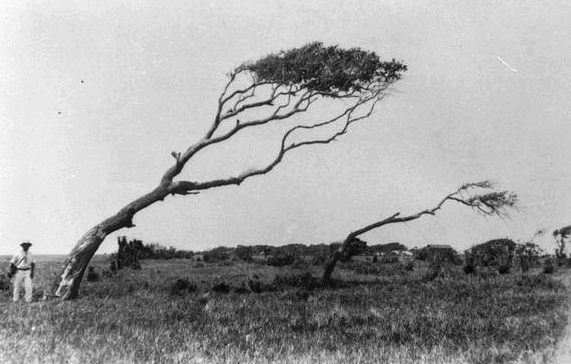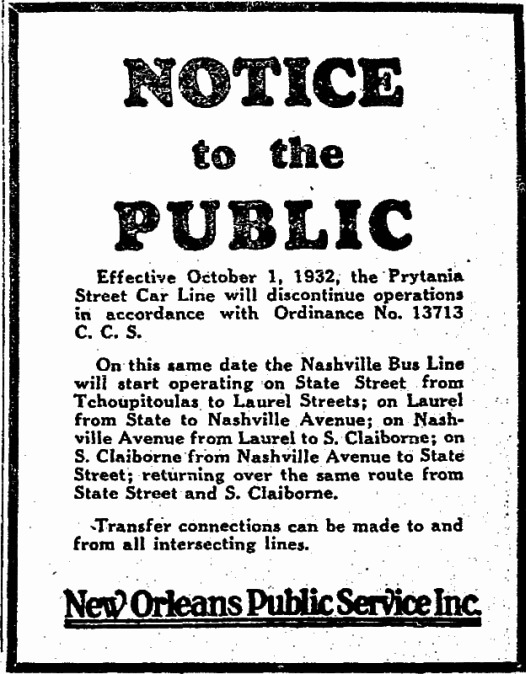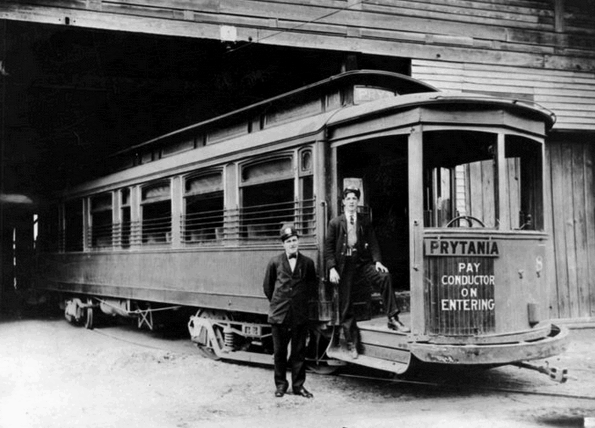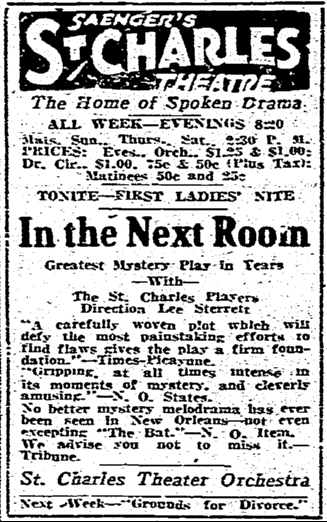|
Today in New Orleans History |
|
|
October 1


 To receive an update for each day in New Orleans history,
join our facebook page - Today in New
Orleans History.
During
the October 1 and 2, 1893 Chenier Caminada Hurricane (also know as the Grand Isle Hurricane), Milneburg was badly
damaged. Two-hundred survivors sought refuge at the Port Pontchartrain lighthouse at Milneburg (later Ponchartrain
Beach). Female light keeper Ellen Wilson was publicly recognized for taking in the newly homeless. The Southern
Yacht Club suffered heavy damage. The block-long Soraparu Market (at Tchoupitoulas Street) collapsed at 11:55 A. M.
on the first of October, a part of it falling on Nogesser's Barroom and destroying it. Water pushed from the lake into the
New Basin Canal caused flooding in the surrounding area where houses were under water. The storm devastated some
500 miles of coastline from Timbalier Bay to Pensacola. The Louisiana settlements along Lake Borgne and the islands from the
Bayou Lafourche east to the Chandeleurs felt the brunt of the hurricane which made landfall between New Orleans and
Port Eads on October 1st. Winds of 100 m.p.h. were estimated at Grand Isle and at Pointe a la Hache. High winds were
noted as far west as Abbeville. By 10 p.m., as winds continued to increase, water began covering coastal islands.
A tidal surge crashed the north end of Grand Isle, destroying everything in its path. The eye passed between 11 p.m.
and midnight. The storm surge was as high as 15 feet in Louisiana bays, 16 feet at Chandeleur Island. The Barataria
Bay lighthouse was almost demolished. The Chandeleur Island lighthouse took on a several foot tilt; waves washed over the
lantern, which was 50 feet above seas level. Severe damage was dealt to the Lake Borgne lighthouse; its metal roof
sheared off by the wind. Two thousand people died, 779 from Cheniere Caminanda and 250 at Grand Lake alone.
Immense destruction of shipping occurred, islands were stripped of vegetation, and property losses of around $5 million
were seen with the storm. Four churches were blown down across the state. In stature, it was considered more than an
equal to the 1856 hurricane. One of the survivors was rescued in a makeshift raft off South Pass 8 days later, almost
100 miles from where he began in Cheniere Caminanda. (NOAA) Related reading: Chita: A Memory of Last Island by Lafcadio Hearn.  To receive an update for each day in New Orleans
history, join our facebook page
- Today in New Orleans History
Jefferson Parish Sheriff Harry Lee passed away on October
1, 2007 after a valiant battle with Leukemia. He will long be remembered as a strong leader and New Orleans character
who never failed to speak his truth (his was a non-politically correct mind). After Sheriff Lee’s death even those
who disagreed with him in life praised his dedication and his commitment to serve his community.
In 1928, Phillip "Dandy Phil" Kastel went to work for New York mobster Frank Costello and
later moved to New Orleans to establish gambling operations, primarily slot machines, during the mid-1930s. Between 1935
and 1937, the Costello-Kastel partnership earned an income of over $2.4 million from slot machines alone according to federal
authorities. Although both were charged in 1939 for tax evasion, Kastel and Costello were both acquitted. By the 1940s,
with control over the majority of gambling in Louisiana, both legal and illegal, Kastel and Costello began to expand their
operations opening high class gambling casinos in Jefferson Parish and earning millions of dollars. The October
1, 1951 edition of Life Magazine included, “Things are tougher for gamblers in Jefferson Parish where Frank
Costello and Phil Kastel once operated one of America's finest gambling clubs, [The Beverly]. Sheriff Frank Clancy who
piously agreed with Senator Tobey [at Senator Estes Kefauver's federal Special Committee to Investigate Organized Crime in
Interstate Commerce] in Washington hearing that gambling was evil promised the committee he would close down his kingdom”.
This was not done and Kastel continued to run the organization throughout the 1950s without interference from city or parish
officials, most notably Jefferson Parish Sheriff Frank Clancey. In 1956 Kastel's fine Old Metairie home was up
for auction. – he was busy preparing for the opening of the $15 million Tropicana casino in Las Vegas. Back
at home, gambling operations declined and were eventually taken over by Carlos Marcello. On August 16, 1962, in failing
health, having lost his sight in one eye and worsening vision in the other, Kastel died an apparently self-inflicted gunshot
wound to the head at his his apartment in the Claiborne Towers (later renamed Grand Palace Hotel which was demolished
July 22, 2012 to make way for the new University Medical Center, a replacement for Charity Hospital). The Prytania Streetcar Line was serviced almost exclusively by the "Prytanias,"
a luxurious class of electric cars just as distinctive as the elegant "Garden District" neighborhood. Fifty cars
were ordered on April 21, 1910 from the St. Louisi Car Company. The exteriors were painted yellow and orange and their
numbers ran from 355 to 404. Mahogany interiors surrounded patrons seated in St. Louis rattan seats. They looked out
of Robertson windows that slid conveniently into side panels when open. The "Prytania" cars were designed for
double-end operation and the prepayment of fares, the first of its type in New Orleans.
The 800 model cars replaced the Prytanias on September 16, 1923. The Prytanias were then shifted to lighter traffic
routes. A public's changing preference for private transportation made streetcar operation unprofitable. According
to a New Orleans Public Service Inc. newspaper announcement, the Prytania Streetcar Line discontinued operations on October
1, 1932 and the Nashville Bus Line began service over a part of the territory formerly served by the line. Prytania Street,
itself, was not included. Remaining Prytanias were scrapped that same year. The Prytania streetcar barn was located
on Prytania Street between Robert, Pitt, and Upperline. After the city acquired the property, a 1936 ordinance dedicated
it for "public purposes". The location is now a shopping center, fronting Prytania, with a CVC pharmacy (4901
Prytania) as its anchor. Main Source: http://neworleanshistorical.org/items/show/540#.Ukfi9X9dy8A
Sherwood Mangiapane was born in New Orleans on October 1, 1912. Known for playing his
bass fiddle ''backwards" -- he actually played left-handed which gave that impression. As a boy he played drums
and switched to the bass during his teens. Never having learned to read music, he was an exceptional musician.
During his career, he played with Papa Jack Laine, Muggsy Spanier, Dutch Andrus, Johnny Wiggs, Edmond Souchon, Tony Almerico,
Alvin Alcorn, Blue Lu Barker, the Preservation Hall Jazz Band and was last associated with the Louisiana
Reperatory Jazz Ensemble, a jazz group dedicated to playing early jazz standards researched at the archives of Tulane University.
He died on January 23, 1992 of complications from diabetes at the age of 79. On October 1, 1811, the first steamboat reached New Orleans by way of the Mississippi River.
Named The New Orleans it left from Pittsburgh, carried a crew of nine, four servants, a dog, and Mr. and Mrs. Nicholas J.
Roosevelt,and arrived in the city 13 days later. Roosevelt was an inventor, a major investor in Upstate New York land,
and a great-grand uncle of President Theodore Roosevelt. His primary invention was to introduce vertical paddle wheels
and he had worked with Robert Fulton in their development. Roosevelt designed and built The New Orleans. He was
married to Lydia Latrobe, daughter of his best friend and business partner, Benjamin Henry Latrobe, architect of the
Custom House, New Orleans waterworks, Frank's Island Lighthouse at the mouth of the river, New Orleans' Charity Hospital,
the central tower of the St. Louis Cathedral, and the French
Opera House. On Saturday, April 30, 1803, the Louisiana Purchase Treaty was signed by Robert Livingston, James Monroe, and Barbé
Marbois in Paris. Jefferson announced the treaty to the American people on July 4. After the signing of the Louisiana Purchase
agreement in 1803, Livingston made this famous statement, "We have lived long, but this is the noblest work of our
whole lives...From this day the United States take their place among the powers of the first rank." The United
States Senate ratified the treaty with a vote of twenty-four to seven on October 20. The Senators who voted against the
treaty were: Simeon Olcott and William Plumer of New Hampshire, William Wells and Samuel White of Delaware, James Hillhouse
and Uriah Tracy of Connecticut, and Timothy Pickering of Massachusetts. On the following day, the Senate authorized President
Jefferson to take possession of the territory and establish a temporary military government. In legislation enacted on October
31, Congress made temporary provisions for local civil government to continue as it had under French and Spanish rule and
authorized the President to use military forces to maintain order. Plans were also set forth for several missions to explore
and chart the territory, the most famous being the Lewis and Clark Expedition. France turned New Orleans over on December
20, 1803 at The Cabildo. On March 10, 1804, a formal ceremony was conducted in St. Louis to transfer ownership of the territory
from France to the United States. Effective on October 1, 1804, the purchased territory was organized
into the Territory of Orleans (most of which became the state of Louisiana) and the District of Louisiana, which was temporarily
under the control of the governor and judges of the Indiana Territory. Blaise Cenas was appointed the first New Orleans postmaster on
October 1, 1804. Born in Marseilles, France in 1802 or 1803, he held the postion
until April 1, 1810. He was responsible for establishing the first workable postal system and
post roads in the New Orleans area. Cenas also served as sheriff in New Orleans until his death on March 25, 1812. On October 1, 1800, Spain ceded Louisiana to France in a secret treaty titled the
Preliminary and Secret Treaty between the French Republic and His Catholic Majesty the King of Spain, Concerning the Aggrandizement
of His Royal Highness the Infant Duke of Parma in Italy and the Retrocession of Louisiana (better known as The Third Treaty
of San Ildefonso). It was a secretly negotiated to return the colonial territory of Louisiana to France and was concluded
on October 1, 1800 between Louis Alexandre Berthier representing France and Don Mariano Luis
de Urquijo for Spain. The treaty was negotiated under some duress, as Spain was under pressure from Napoleon, although Spain
did gain the Tuscany area. The terms of the treaty did not specify the boundaries of the territory being returned, which
later became a point of contention between Spain and the United States after the Louisiana Purchase in 1803. |
|
|

To receive an update for each day in New Orleans history,
join our facebook page - Today in New
Orleans History.
Analytics |





